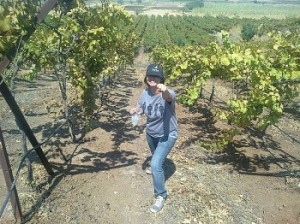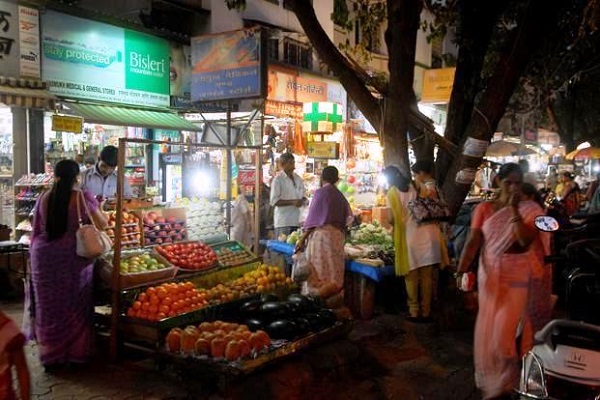Najeshda Deshpande started out in Financial Accounting and Auditing, but found her vocation during a chance meeting with surfers in Australia.
by Salil Jayakar | @Salilicious on Twitter
At SulaFest 2015, the oenophile in me was quite delighted to see that winemaker Hardys was on board as wine partner. Holding forth on their wines and food pairings was the bubbly Najeshda  (‘hope’ in Russian) Deshpande (in pic on right), Sula’s import manager. A short conversation later I learnt that she was a Mumbai girl (from Vile Parle, no less) and that we had common friends. Intrigued by this Marathi mulgi’s career choice, I dug deeper only to learn that Najeshda’s love affair with wine started quite by chance on a holiday in Australia. “I was done with number crunching and didn’t quite know what to do next. I made friends with wine-making surfers and here I am today,” she told me.
(‘hope’ in Russian) Deshpande (in pic on right), Sula’s import manager. A short conversation later I learnt that she was a Mumbai girl (from Vile Parle, no less) and that we had common friends. Intrigued by this Marathi mulgi’s career choice, I dug deeper only to learn that Najeshda’s love affair with wine started quite by chance on a holiday in Australia. “I was done with number crunching and didn’t quite know what to do next. I made friends with wine-making surfers and here I am today,” she told me.
Read on to know more about Najeshda’s career journey, the work she does and why she loves what she does…
Tell us about your days in college and the career choices you made.
College was a bit of a blur for me. I got myself into Financial Accounting and Auditing at the start of my B.Com but spent far more time on various student activity committees, clubs and causes than in a classroom. At the end I had a ‘respectable’ degree and I was finally free to find myself a real passion. It is an education that stood me in good stead later on in my career but I never saw a future for myself in it.
How did your interest in wine come about?
Looking back I’m fairly certain it was destined to be. I had a number of run-ins with the thought of working in wine. It offered the romantic notion of travel which immediately appealed to me. Steeped in existential angst and completely unable to stomach the idea of a career in finance, my family in Australia was kind enough to let me sulk around for a summer in 2005. My grandmother took me to Esperance in Western Australia one week on a camping trip to Hell Fire Bay. Having trekked across a small hill to a secluded beach one morning, we chanced on three surfers. They turned out to be winemakers at the only winery in the area. We got talking and they told me a girl who wanted to travel – needed to be in wine. That simple! Their crazy passion about all that they did was mesmerising. I wanted to feel that strongly about what I did for a living. It was a slow burn but the surfing winemakers and their passion is what stuck. I have seen it since in some of the best in the wine industry.
So where did you study and what was that experience like?
After college and my summer away, I got into the post graduate diploma programme in advertising and marketing at Xavier Institute of Communications (XIC), Mumbai. It was fun and I loved my first job as a copywriter; I had almost forgotten about wine. Just as I was beginning to settle in I found a brief for a wine company lying on my desk one day. Working on that account brought back memories of the winemakers. It reminded me also of my brief (failed) attempt to work on a Sula marketing group project at XIC. Not everyone shared my enthusiasm at the time. I wished I had stayed in touch with the winemakers.
 I had three months to get into the Masters in Wine Business programme at the University of Adelaide. I had no wine experience and was deemed too young for the course. A fervently passionate essay on my belief in the future of the wine industry (in India) is what worked in my favour. We started as a class of 20. A year and a half later of oenology, viticulture, winery management, wine tourism, international wine laws, global trade trends and a thesis in consumer behaviour, only 12 survived. We had access to some of the best in the business – a winery on campus, two vineyards and researchers from the Australian Wine Research Institute (AWRI). My days in Adelaide were filled with weekend trips to Barossa or McLaren Vale, occasionally hopping across to Mornington or Yarra, a part time job to fund my travel and a lot of time at the massive oenology and viticulture library at the Waite campus to ensure I stayed on par with the rest of the class – older, more experienced and far more knowledgeable in wine than me. I’d jumped in at the deep end and loved every challenging minute of it!
I had three months to get into the Masters in Wine Business programme at the University of Adelaide. I had no wine experience and was deemed too young for the course. A fervently passionate essay on my belief in the future of the wine industry (in India) is what worked in my favour. We started as a class of 20. A year and a half later of oenology, viticulture, winery management, wine tourism, international wine laws, global trade trends and a thesis in consumer behaviour, only 12 survived. We had access to some of the best in the business – a winery on campus, two vineyards and researchers from the Australian Wine Research Institute (AWRI). My days in Adelaide were filled with weekend trips to Barossa or McLaren Vale, occasionally hopping across to Mornington or Yarra, a part time job to fund my travel and a lot of time at the massive oenology and viticulture library at the Waite campus to ensure I stayed on par with the rest of the class – older, more experienced and far more knowledgeable in wine than me. I’d jumped in at the deep end and loved every challenging minute of it!
Apart from our industry projects, I got myself an internship at the Australian Wine and Brandy Corporation over the summer in Adelaide. They had projects for me in the international market development and export compliance cells. It was the first time I had clarity in a profile – three years on, Sula modified an existing opening for their import department and offered me my dream job.
How did your parents react?
My parents were extremely supportive. They understood the potential for the industry in India; understood I was asking them to invest in an education from one of the best schools in the field. Eventually though, it was the first time they’d seen me passionate and committed to a vocation.
Tell us about your role at Sula.
A job posting on a blog and a Skype interview with the head of International Business and I was in. Today, I work as the Import Manager at Sula. My job is to understand and decode the Indian market for some of the biggest wine companies in the business and convince them to invest in India. The two aspects of my job I enjoy the most are the annual reviews for new brand additions alongside industry veterans, sommeliers and the occasional visiting winemaker from Nasik – always ground for a very lively debate. The other aspect is the chance to travel often to our key markets  across the country. Events and exhibitions, F&B trainings and feedback from our regional offices are invaluable opportunities to learn from. Understanding the commercial, marketing needs of each market and gaining insight to the ever evolving Indian wine consumer fascinates me no end. To then also be allowed to use this insight and become a part of our future offerings in imported wines, beer and spirits is simply thrilling.
across the country. Events and exhibitions, F&B trainings and feedback from our regional offices are invaluable opportunities to learn from. Understanding the commercial, marketing needs of each market and gaining insight to the ever evolving Indian wine consumer fascinates me no end. To then also be allowed to use this insight and become a part of our future offerings in imported wines, beer and spirits is simply thrilling.
Travelling across India for work led to me discovering a whole new side of the country. I’ve gone exploring in Hampi, scuba diving in the Andaman’s and my world came full-circle last year when I discovered surfing in Pondicherry.
What’s the best part of your work? And challenges? If yes, how do you overcome them?
The best part of my job are my peers from across the industry. Internally too, Sula’s work force largely consists of self-motivated, entrepreneurial kindred spirits. The company of those who are so passionate about their roles is the reward and the challenge. In the end, the common goal and zeal of representing Sula gets us through the day.
Your advice to those who want to make a career in the wine industry?
A big heart, an insatiable quest for knowledge and a strong constitution.
Famous last words…
Do the things that scare you…you will surprise yourself!
(Pictures courtesy Najeshda Deshpande)





